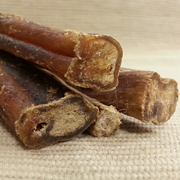Rawhide Bones

It makes sense that rawhide bones are such a popular dog chew. Dogs enjoy chewing them, and they can last for hours, keeping your dog busy and occupied.
But the problem with rawhide bones is their toxicity and the effect these toxins can have on your dog’s health. Once you discover how rawhide bones are made, you will probably never want your dog to touch one, let alone eat one!
Behind the Scenes: How Rawhide Bones are Made
You may be shocked to learn how rawhide bones are made. Contrary to popular belief, rawhide bones are not made of dehydrated meat. Instead, they are a leather chew.
Once shipped from slaughterhouses, cattle hides are processed at tanneries. To keep them from spoiling, they are treated with chemicals.
One treatment with chemicals is enough to deter me from ever giving one to my dog. But there’s more…
The tanneries need to make it easier to split the cattle hides into layers. How do they do this you ask?
Well, they treat them with chemicals so that the hides become puffier.
Now the hide’s outer layer can be used to make various products such as purses, car seats, etc. But the inner layer, along with other questionable ingredients such as glue, gelatin and cosmetics, are used to make the rawhide bones. Yuck!
As if that’s not enough!
Manufacturers want the hides to look more pleasing to the eye. So they wash the hides with a hydrogen peroxide and/or bleach solution. This whitens the rawhide and also gets rid of the rotten smell of leather.
It can’t get worse than this, can it?
Yes, it can.
Some manufacturers prefer that the bones look even more vividly white, so they may use titanium oxide. Or they may use artificial dyes and flavors to make them look more colorful or improve the taste. (More toxins!)
Sorry, there’s more…
In addition to potentially dangerous chemical toxins, there have been incidents where dogs have eaten a piece of rawhide that gets stuck in in the intestinal tract.
Plus, dogs can break teeth when chewing rawhides.
I don’t know about you, but I won’t be giving my dog rawhide bones!
Safe Alternatives to Rawhide Bones
There are many safe chews available for dogs. By feeding these you don’t have to feel worried that you may be giving something harmful to your dog.
The first three chews are made with free-range, grass-fed buffalo (no additives or preservatives).

- Free-range, grass-fed buffalo
- Help reduce tartar and maintain canine dental health
- Supply a leaner alternative to beef
- Are suitable for dogs with food sensitivities
- Contain no additives or preservatives
- Provide a rewarding chewing experience

- Free-range, grass-fed buffalo
- Supply a leaner alternative to beef
- Are suitable for dogs with food sensitivities
- Contain no additives or preservatives
- Provide a rewarding chewing experience

- Flavorful and oh-so-satisfying chews
- Free-range, grass-fed buffalo
- No additives or preservatives
- Pure chewing satisfaction without digestive upset

- Packed with high-quality protein
- Irresistible flavor and chewing satisfaction
- No harsh preservatives or artificial flavors and colors
- Made in the USA
- Organic
- All natural
, chemical free
- Long lasting chew
- Made in the USA
- Organic
- All natural healthy chew
- From Montana
Foods you may already have in your kitchen!
Carrots
Great source of antioxidants and full of vitamins and minerals. Feed at room temperature or serve frozen if you want them to last longer.
Frozen apples
Rich in antioxidants, flavinoids and dietary fiber. There’s a reason for the saying, “An apple a day keeps the doctor away!”
Frozen sweet potatoes
Provides Vitamins B6, C and D, magnesium, potassium and iron. Delicious and so healthy!
Resources:
Whole Dog Journal
The Bark
Dogs Naturally Magazine
Vet Street



